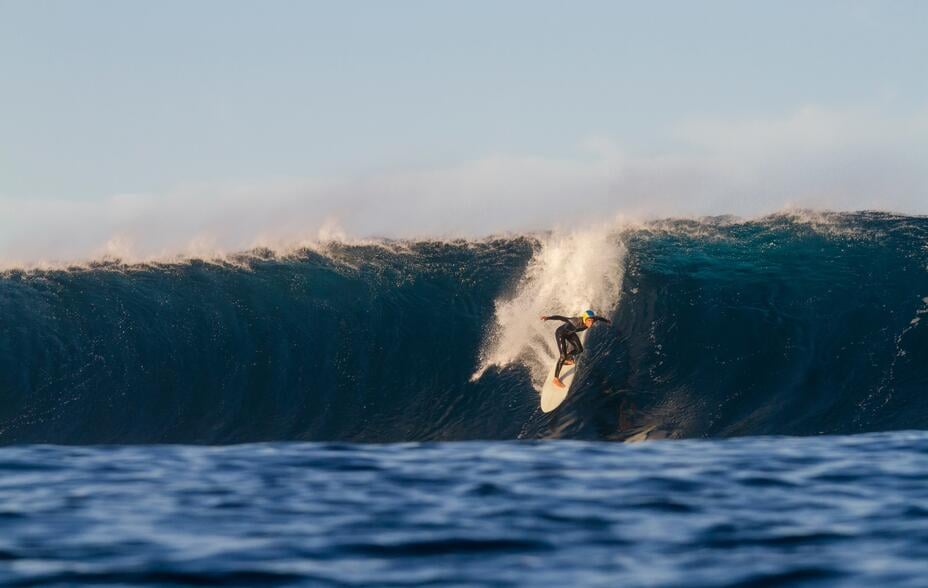
Investors should consider the investment objectives, risks, charges and expenses carefully before investing. This information and other information about the Funds can be found in the prospectus and summary prospectus. For a prospectus and summary prospectus, please visit our website at bailliegifford.com/usmutualfunds. Please carefully read the Fund's prospectus and related documents before investing. Securities are offered through Baillie Gifford Funds Services LLC, an affiliate of Baillie Gifford Overseas Ltd and a member of FINRA.
Introduction
I grew up surfing the Welsh coast with my father. As an enthusiastic nipper, I would throw myself into any wave that came my way – big, small, lumpy, or smooth, I would paddle in. This led to an entertaining watch for anyone on the shore as I tumbled head over heels into the water. This was in stark contrast to my father who was far more reserved with his selection. I would appropriately tease him over the lack of waves he caught, but as time went by, I began to appreciate his craft.
He would position himself far out away from the crowd, maintain a focus on the horizon, and patiently wait for the wave with the right shape, size, and direction. When that wave came, he was the one in the right position to catch it. But he was never complacent, and still paddled harder than anyone in the lineup – utilising all his saved energy – to ensure that he had the privilege of riding it.
The waves I caught were short and punchy providing one or two exciting moments before fizzling out. The waves my father caught would roll all the way along the bay, building in both magnitude and speed, with a profile and shape that allowed him to string multiple manoeuvres together. I would catch more, but he would catch better. I frequently think about the lessons I learned surfing when investing, especially when trying to uncover the exceptional companies in our investment universe.
The importance of focus
Focus underpinned my father’s whole strategy: He focused intently on selecting the right wave and putting himself in the best position to catch it. I see many parallels between his approach and the best-run companies in our investment universe.
A business must make hard choices about the markets it wants to enter, and how it positions itself to serve such markets. Indeed, there is much said about the optionality of sowing many seeds, but ultimately if two businesses are competing to serve a single market it is the one that can allocate the most amount of talent, resources, and time that wins – the latter often being overlooked. Analysis of some of the most successful companies in our universe highlights their considerable restraint. However, such analysis also reveals that when the rare opportunity of pivotal growth presents itself, these companies invest substantial resources in winning and cementing their position as the market leader. Mercado Libre (Meli) – a business International Alpha has owned since 2010 – is a fitting example.
Meli – Latin America’s answer to Amazon – was founded by Marcos Galperin who still leads the business today. Meli established itself as the number one ecommerce platform in Latin America by 2015 and began to command handsome profits. The company could have rested on such success, Galperin strove to drive further growth and strengthen the company’s competitive position by making a bold decision to make heavy investments into in-house logistics, to create a physical infrastructure that few could match without huge capital investment. Growth was accelerated through the free or discounted delivery to build vital scale that would secure dominance of its markets. Capital was also poured into the finance and payments business, not for profits in the near term, but for the value that could be created in the midterm and well beyond. Such investments contributed to operating profit margins falling from 21% in 2016 to -7% in 2019, but such investment fortified its ecommerce business and helped onboard the vast unbanked population of Latin America to online marketplaces and create a more seamless payment ecosystem around the core ecommerce platform fortifying its moat (competitive advantage). Meli has since become one of the region’s leading finance platforms – with 46 million monthly active users in 2023 – whilst concurrently defending its leading position in ecommerce. Operating profit has not only recovered but is nine times higher than 2016.
Meli’s story stresses the point that markets are rarely won overnight, and years of deep investment are often a pre-requisite to drive technology forward or to build a brand of iconic status. Companies need to position themselves differently from competitors for lengthy periods of time, and such positioning inevitably results in sacrificing short-term sales or profitability. But fundamentally, if competitors are unwilling, or unable, to match long-duration focused investments and the market begins to value them, the kernel of competitive edge is established.
Good strategy works by focusing energy and resources on one, or a very few, pivotal objectives whose accomplishment will lead to a cascade of favourable outcomes.
Another business whose focus and commitment to the long-term we admire is Shimano – the Japanese bicycle parts manufacturer. Shimano has consistently invested in improving and innovating its bicycle parts for close to a century, with components like the ‘Dura-Ace group set’ being iterated on for what marked 50 years in 2024. As a result, Shimano products are considered the de facto industry standard, and the quality of a bike is often judged by how many Shimano parts it has. We have owned Shimano since 2011, and we continue to be impressed by management’s unwavering focus on improving the technology and the overarching long-term mindset in which they approach their business.
Critically, a focused strategy can also be consequential to the scalability and durability of a company’s culture – a factor immediate to a company’s long-term growth prospects. A focused strategy aligns a workforce and helps conjure a playing-to-win mindset. When every employee knows the strengths, the mission, and the purpose of the company – a clear north star – decision making can become more decentralised allowing companies to move faster as management can trust that the decisions being made are ultimately in service to the company reaching its goal. Greater trust can also lead to leaner organisations with more accountable and empowered employees, contributing to the company maintaining high standards, agility, and performance as it scales. Atlas Copco (Atlas) is an archetype of such decentralisation. Atlas champions the freedom and accountability of employees, with the guiding principle of ‘There is always a better way’. Despite Atlas’ profits increasing more than eight-fold since 2003, the employee count has only doubled, underscoring how a focused strategy can have a stark impact on the culture and efficiency of a business.
When a company does not have a focused strategy – and employees are unsure of the direction and strengths of the business – it is difficult to work towards a common goal. Progress cannot compound as easily from one day to the next. A focused strategy results in a greater chance of winning your market, but it also results in a greater chance of scaling an effective culture and maintaining that lead as you grow.
The importance of alignment
It is crucial to emphasise that a company’s progress is not linear, and its strategy will not always be in favour – drugs fail trials, fashion trends change, and short-term fluxes in macroeconomic conditions can scupper successive years of growth. If a company is under continued pressure to deliver short-term results from shareholders, and management is not aligned with long-term success, there is material risk that the company will deviate from its strategy, cut costs to sustain profitability, and reduce investments that would otherwise fuel its prospects. Management will skate to where the puck is, rather than where it is going.
A focused strategy and playing-to-win mindset are only possible if the management team has full confidence that they can make long-term orientated decisions with the support of the board and owners. A company can have the deepest and widest moat, but if there is not an ownership structure and culture that allows the moat to remain filled in times of drought, the moat is not worth digging.
We find that some of the leading companies in our universe often have such an ownership structure – whether that be a significant inside owner in the form of a founder or family, or a longstanding institutional investor – that allows for decisive and ambitious decision making to occur. When we look at our holdings, Daniel Ek – the CEO and founder of Spotify – is a notable example. In 2018, Ek announced the company would invest $500m in growing its podcast business – a bold bet that was met with considerable criticism at the time. Spotify has since become the number one podcast publisher in key markets like the U.S., reinforcing its competitive position as the world’s most popular audio subscription service.
The worst thing that a company can do, like a sports team, is start playing defence because you’re afraid to fail

The ability to focus and make long-term investments to win key markets – whether that be bicycle components or audio streaming – is only possible if you have an underlying business model that is sustainable. Companies which produce consistently high free cash flow, generate high returns, and have little debt to service can inherently be more selective on the markets they enter, and can better sustain growth investments once they do – they are the masters of their own destiny.
Over the last 20 years, Rational – the German oven manufacturer – has consistently produced earnings before interest, taxes, depreciation and amortisation (EBITDA) margins north of 20%. Such sustained profitability has allowed the company to fund a persistent push into international markets like the USA – but critically, the expansion has been on its terms. Rational is often challenged on their rate of growth in the USA, but this is a product of their focused strategy of only offering ovens, rather than a wider range of kitchen appliances like their competitors. The market for their flagship combi steamer is still significantly underpenetrated in the USA, and winning this market may result in profitable – and therefore more sustainable – growth deep into the future… rather than a quick flash in the pan.
We believe in the law of focus and specialisation. If you do less, you are more successful
The importance of looking forward
What fascinates us is that only some of the characteristics discussed here – primarily the financial ones – are traditionally emphasised by the investment community as hallmarks of a quality business. There is credence to focusing on characteristics like high returns, sustainable earnings, and low financial leverage, given that the quality index selected on these metrics alone has outperformed the market over extended periods. But as we have alluded to, we believe that some of the highest quality businesses in the International Alpha portfolio are not defined by their current financial metrics, but rather the focus of their strategy and the magnitude of their opportunity.
We must be cognisant that metrics are not ‘inputs’ into a business but rather the ‘outputs’, and such tight definitions of quality can exclude some of the best companies with the most focused and durable strategies. Many of the leading businesses in our universe do not currently have a high return on equity (ROE) – and thus would be excluded from typical ‘quality screens’ – because such companies are undertaking investments to fortify their competitive position and fuel their long-term growth prospects thus obfuscating the true strength of their business model. Whether it be a new financial services platform to tap into the underbanked of South America, or the hiring of new engineers to develop the latest and greatest bicycle brakes, contemporary accounting standards are inept at capturing the true value of such investments.
Thus, we must remember that such quality metrics are inherently backwards-looking, and the sustainability of quality going forward – the inputs – is a product of the strategy, the people, the competitive edge, and the magnitude of the growth opportunity. Whether it is due to such inputs not being easily quantifiable, the market still fundamentally underestimates their ultimate confluence – the duration of growth.
If a company has positioned itself at the centre of an expanding industry with bold and focused investments, and has a management team and culture that is effective in sustaining that competitive position, the durability of growth can result in current valuation techniques being a poor reflection of future value creation. Taiwan Semiconductor Manufacturing Company (TSMC) is a prominent example.
Over our holding period in TSMC, semiconductor innovation has spawned myriads of new markets and is one of the key pillars of human progress, underpinning everything from how we discover new ways to treat cancer, to powering the latest electric vehicles. Indeed, there are short and punchy waves of excitement that come and go in technology, but there has been more than half a century of continual progression of the underlying semiconductor that drives the industry. TSMC had a formidable leader in Morris Chang who strategically positioned TSMC as one of the pivotal actors in the semiconductor industry with a unique business model and unmatched levels of investment – in both quantum and time – in talent and resources. TSMC has become one of the most successful companies in our universe. Earnings have grown at a compound annual rate of ~13% between 2005 and 2023, far outstripping the market.
Without strategy, execution is aimless. Without execution, strategy is useless.
International Alpha in focus
The market prizes backward-looking metrics to gauge a company’s quality and prospects. But true quality goes beyond metrics; it thrives on strategic focus. This focus is pivotal – it concentrates investments, leverages strengths, empowers teams, thereby forging a durable business. When aimed at vast and expanding opportunities, it can drive growth far beyond market forecasts. Thus, our edge as long-term investors are to take a more holistic approach to what constitutes ‘quality’ and to place more emphasis on forward-looking inputs, spotlighting strategic focus. By layering these insights, we may unearth not just the quality, but the exceptional companies in our universe.
As investors, we can also practice focus. Reflecting on my years of surfing with my father, the main lesson was not to paddle for every wave but to find those that built in magnitude and had the potential to be the longest lasting. Similarly, we may not catch every technological breakthrough or every new brand, but our aim is to identify significant structural growth trends and uncover the companies making bold and focused investments that drive them – investments that could be the initial ripples of an industry forming, with the potential to evolve into a great wave of change.

RISK FACTORS
This content contains information on investments which does not constitute independent research. Accordingly, it is not subject to the protections afforded to independent research and Baillie Gifford and its staff may have dealt in the investments concerned.
As with all mutual funds, the value of an investment in the fund could decline, so you could lose money.
The most significant risks of an investment in the Baillie Gifford International Alpha Fund are Investment Style Risk, Growth Stock Risk, Long-Term Investment Strategy Risk and Non-U.S. Investment Risk. The Fund is managed on a bottom up basis and stock selection is likely to be the main driver of investment returns. Returns are unlikely to track the movements of the benchmark. The prices of growth stocks can be based largely on expectations of future earnings and can decline significantly in reaction to negative news. The Fund is managed on a long-term outlook, meaning that the Fund managers look for investments that they think will make returns over a number of years, rather than over shorter time periods. Non-U.S. securities are subject to additional risks, including less liquidity, increased volatility, less transparency, withholding or other taxes and increased vulnerability to adverse changes in local and global economic conditions. There can be less regulation and possible fluctuation in value due to adverse political conditions. Other Fund risks include: Asia Risk, China Risk, Conflicts of Interest Risk, Currency Risk, Emerging Markets Risk, Equity Securities Risk, Environmental, Social and Governance Risk, Focused Investment Risk, Geographic Focus Risk, Government and Regulatory Risk, Information Technology Risk, Initial Public Offering Risk, Japan Risk, Large-Capitialization Securities Risk, Liquidity Risk, Market Disruption and Geopolitical Risk, Market Risk, Service Provider Risk, Settlement Risk, Small-and Medium-Capitalization Securities Risk and Valuation Risk.
For more information about these and other risks of an investment in the fund, see “Principal Investment Risks” and “Additional Investment Strategies” in the prospectus. The Baillie Gifford International Alpha Fund seeks capital appreciation. There can be no assurance, however, that the fund will achieve its investment objective.
The fund is distributed by Baillie Gifford Funds Services LLC. Baillie Gifford Funds Services LLC is registered as a broker-dealer with the SEC, a member of FINRA and is an affiliate of Baillie Gifford Overseas Limited.
All information is sourced from Baillie Gifford & Co and is current unless otherwise stated.
The images used in this article are for illustrative purposes only.
Top Ten Holdings. As at 30 September 2024.
| Holdings | Fund % |
| MercadoLibre | 4.70 |
| TSMC | 4.47 |
| Tencent | 3.19 |
| CRH | 2.62 |
| SAP | 2.54 |
| Samsung Electronic | 2.28 |
| Scout24 | 2.27 |
| Ryanair | 2.20 |
| Atlas Copco | 2.08 |
| Deutsche Börse | 2.07 |
It should not be assumed that recommendations/transactions made in the future will be profitable or will equal performance of the securities mentioned. A full list of holdings is available on request. The composition of the fund's holdings is subject to change. Percentages are based on securities at market value.
121418 10050563


